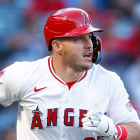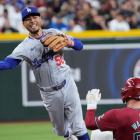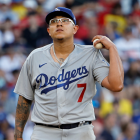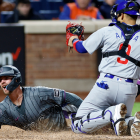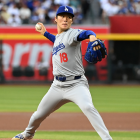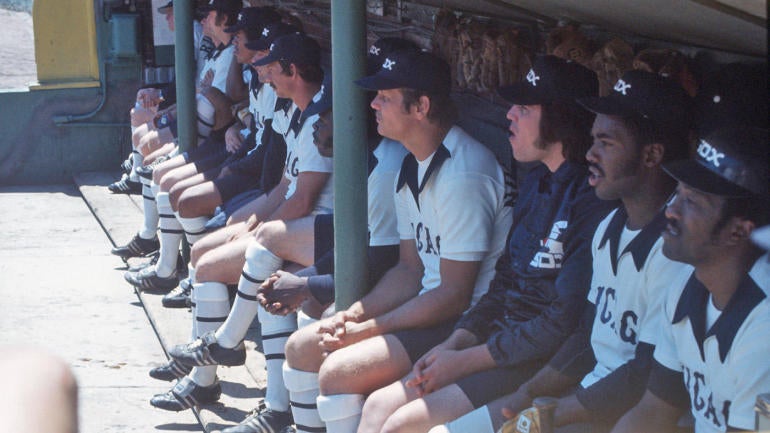
One of the leading subplots of spring training has been the controversy surrounding Major League Baseball's new player uniforms. The unis, designed by Nike and produced by Fanatics with athletic performance in mind, have proved unpopular with a number of players because of, to hear various players tell it, the lack of comfort, the visibility of the name and number, the "cheap" feel and look of it, and – most notable of all – the revealing qualities of the pants.
While we don't know how the issue will be resolved or not resolved, we do know that we can use this occasion to revisit the history of baseball uniform innovations and touchstone moments across the history of the sport, whether good, bad, or somewhere in the middle. What follows will not be a completely exhaustive treatment of the subject at hand, but it will highlight the most critical junctures of the evolution of the baseball uniform. Let's undertake this now, in timeline format.
April 24, 1849 - The New York Knickerbockers become the first organized baseball club to adopt an official uniform. The uniform consists of blue pants, white flannel jerseys, and white straw hats.
July 15, 1867 - The Cincinnati Red Stockings, a couple of years before becoming the first organized professional baseball team, are the first to wear knicker-style pants that ride at or above the knee as opposed to traditional-length pants.
1876 - Harvard catcher Alexander Tyng wears the first catcher's mask, which was a modified fencing mask.
1882 - The National League experiments by assigning different uniform designs to players based on the positions they play. The experiment is abandoned by mid-season.
April 14, 1904 - The Detroit Tigers for their Opening Day contest against the St. Louis Browns debut the iconic "Olde English D" on their uniforms. The franchise signature remains part of the Tigers' uniforms and branding more than a century later.
1905 - The first "sanitary socks" are introduced in baseball.
1906 - Coming off a victory over the Philadelphia Athletics in the 1905 World Series, John McGraw's New York Giants for the 1906 season wear jerseys that read "World's Champions" across the front. Those jerseys are also the first collarless ones worn by a major-league team.
1907 - The Reading Red Roses of the Atlantic League became the first professional club to wear uniform numbers. This same year, the Boston Doves – later to become the Braves – were the first team to wear pinstripes.
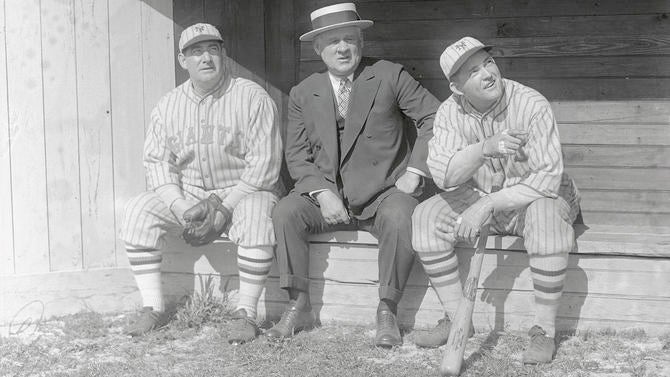
April 11, 1907 - Roger Bresnahan of the New York Giants becomes the first catcher to wear shin guards in a game. The innovation comes some 13 years after pitchers were first permitted to throw overhand. With masks and chest protectors already in use, the full catcher ensemble is thus on display for the first time, as well.
1909 - The Cubs introduce a "cadet-style" standing collar on their jerseys.
1910 - The Boston Red Sox and Boston Doves are the last major-league teams to wear lace-up jerseys.
1912 - The New York Highlanders, later to become known as the New York Yankees, first wear pinstripes on their uniforms. The pinstripes will be abandoned for the 1913 and 1914 seasons but become a permanent presence starting in 1915.
1914 - The Buffalo Blues of the upstart Federal League become the first team to have cursive script adorning their jerseys.
1915 - The Boston Braves become the first major-league team to feature four different uniform designs during the same season.
1916 - Cleveland becomes the first major-league team to wear uniform numbers. The numerals appear on the left sleeve of the jersey. By 1917, however, the team will revert to numberless uniforms. Also in 1916, the Brooklyn Robins, later the Dodgers, wear plaid uniforms. This same year, former big-league outfielder and future Hall of Famer Fred Clarke patents the first flip-up sunglasses.
1922 - The Cardinals introduce the "birds on the bat" logo on their jerseys.
1928 - Detroit adds the image of a Tiger to the back of their road jerseys.
1929 - Cleveland and the New York Yankees open the season as the first big-league teams to wear numbers on the backs of their jerseys.
1936 - The New York Yankees add the interlocking "NY" logo to their jerseys for the first time since 1916. They had first introduced the interlocking NY as a sleeve element in 1909.
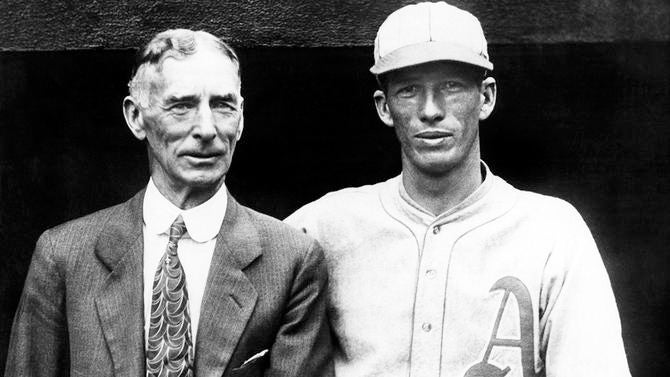
1937 - Connie Mack's Philadelphia A's finally add numerals to their home uniforms, which means that every MLB team now wears uniform numbers in all their games. This same year, the Chicago Cubs become the first team to wear zippered jerseys.
1940 - The Chicago Cubs debut the sleeveless jersey.
1941 - Concerned about a seeming rash of beanings, Brooklyn Dodgers president Larry MacPhail tasks two Johns Hopkins physicians with developing protective headgear for hitters. They eventually settle on plastic guards that are inserted into the hat. Mere weeks into the season, doctors will say that Pete Reiser's life may have been saved by the guards after he's hit on the side of the head by a pitch. Protective headgear will not be mandated for hitters until 1956, and it's not until 1971 that the modern batting helmet becomes required equipment.
1944 - The Dodgers, for their road night games, wear powder-blue satin uniforms in order to provide fans with better visuals under the lights. The experiment ends when players complain about the uncomfortable material.
1950 - The Hollywood Stars of the Pacific Coast League become the first affiliated team to wear short pants.
1951 - The minor-league Springfield Cubs are the first team to wear numbers on the front of their jerseys.
1952 - The Brooklyn Dodgers become the first major-league team to wear numbers on the front of their jerseys. The red numerals, added to their home ensemble, remain a Dodger uniform grace note.
1956 - The Cincinnati Reds remove the word "Reds" from their uniforms in response to anti-Communist sentiment.
1960 - The Chicago White Sox are the first team to put player names on the backs of jerseys. Every team will eventually follow suit except for the New York Yankees.
1961 - Cincinnati returns to being called the Reds after a brief period of being known as the Redlegs. The word "Reds" also returns to their uniforms.
1963 - The A's, now in Kansas City and owned by Charlie Finley, change from a red and blue color scheme to green and gold.
1970 - The Pittsburgh Pirates usher in a new era of baseball fashion by debuting blended cotton-nylon uniforms that feature pullover jerseys and beltless pants.
1975 - The Houston Astros unfurl their new "rainbow jerseys." They also add uniform numbers to their pants.
1976 - To commemorate the 100th anniversary of the National League, multiple senior-circuit teams wear old-timey "pillbox" hats for the 1976 season. Only the Pirates stick with the look beyond that season. They wear the pillbox hats through the 1986 season. Elsewhere, the Chicago White Sox reintroduced collared jerseys.

Aug 8, 1976 - The Chicago White Sox become the first major-league team to wear shorts in a game. They do so in the first game of a doubleheader against the Kansas City Royals.
1978 - The number of teams sporting powder-blue road uniforms swells to a record 10.
May 19, 1979 - The Philadelphia Phillies begin an intended stretch in which they wear all-burgundy uniforms for their Saturday home games. Following a blown lead and loss to the Montreal Expos, however, the Phillies think better of the plans.
1986 - The Philadelphia Phillies become the last team to wear zipper-front jerseys.
1993 - After an absence of more than 20 years, the Cincinnati Reds and Florida Marlins revive sleeveless jerseys.
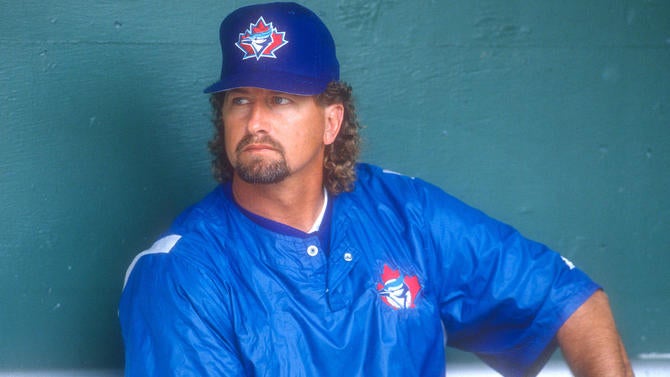
Late 1996 season - Charlie O'Brien of the Toronto Blue Jays pioneers the "hockey-style" catcher's mask.
1997 - Jackie Robinson's uniform No. 42 is retired in perpetuity across all affiliated major- and minor-league teams.
July 18, 1998 - The Seattle Mariners host "Turn Ahead the Clock Night," in which the team dons jerseys deemed to be from the distant future for their Saturday home game against the Kansas City Royals. The promotion was conceived by then-Mariners head of marketing Kevin Martinez in consultation with future Hall of Famer Ken Griffey Jr. So successful was the one-off event that MLB the next season made it a league-wide series of games.
Remember, baseball fans—we are only 6 years away from Turn Ahead the Clock, when all uniforms will look like this: pic.twitter.com/fADK8I5GFI
— Todd Radom (@ToddRadom) March 12, 2015
2014 - Relief pitcher Alex Torres becomes the first to wear a prototype protective headgear for pitchers. The headgear has the appearance of an oversized traditional hat.
Old hat vs. new hat: pic.twitter.com/Ox0iZQasI3
— Marc Carig (@MarcCarig) April 18, 2015
Aug. 10, 2017 - MLB announces the first Players Weekend in which teams will wear a more colorful palette of uniforms designed to evoke Little League and youth baseball. Rules regarding accessory equipment are scaled back temporarily, and players are permitted to put the nickname of their choosing on the backs of their jerseys. The league will also hold Players Weekend in 2018 and 2019.
June 24, 2021 - MLB announces that for the first team ever players participating in the All-Star Game will wear specially designed All-Star uniforms instead of the uniforms of their respective teams.
This same year, MLB, in collaboration with Nike, announced the "City Connect" uniform series. Each team will unveil a specially designed uniform that featured local elements and iconography across multiple years.
Let's take a look at all current MLB City Connect uniforms. It's strange seeing them all together! pic.twitter.com/G2Jhk4ORxl
— Jay Jackson (@DiamondUniforms) June 24, 2023
Spring 2024 - MLB distributes to players new uniforms designed by Nike and manufactured by Fanatics. While the new uniforms are intended to be more performance-oriented on account of the lighter weight and increased breathability and elasticity, they're criticized by many players for being uncomfortable and cheap-looking and for the revealing nature of the pants. The kerfuffle leads to a series of dueling remarks in the media and attempts at damage control by MLB. At this writing, the matter appears to be unresolved.
Sources: Baseball-Reference.com; "Dressed to the Nines" online exhibit, National Baseball Hall of Fame and Museum; Library of Congress; Los Angeles Times archives; MLB.com; SABR.org; SportsLogos.net; ThinkBlueLA.com; Total Baseball, edited by John Thorn, Pete Palmer, and Michael Gershman; Uni-Watch.com














